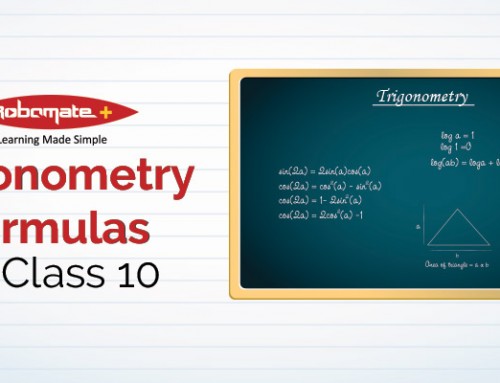Exercise 11.1
1) Draw a line segment of length 7.6 cm and divide it in 5: 8 ration. In addition, find the measure of two parts.
Solution:

Procedure for construction:
- Draw any ray AX, making an acute angle with AB.
- Locate 13(= 5 + 8) points A1, A2, A3 ……… A13 on AX so that AA1 = A1A2 Al2 A13.
- Join BA13.
- Through the point A5(m = 5), draw a line parallel to BA13 (by making an angle equal to L AA13 B at A5 intersecting AB at C. Then AC: CB = 5 : 8)
2) Construct a triangle with sides 4 cm, 5 cm and 6 cm and then a similar triangle to it whose sides are 2/3 of the corresponding sides of the first one.
Solution:

Procedure for construction:
- Draw a line segment BC with length 5 cm.
- With B as centre and radius of 4 cm draw an arc.
- With C as centre and radius of 6 cm draw an arc.
- Join AB and AC. Then, ∆ABC is the required triangle.
- Below BC, make an acute angle ∠CBX
- Along BX, mark up three points B1, B2, B3 such that BB1 = B1 B2 = B2B3
- Join B3C
- From B2, draw B2C’llB3c, meeting BC at C’
- From C’ draw C’ All CA, meeting BA at A’
- Then ∆A’BC’ is the required triangle, each of whose sides is two-third of the corresponding sides of ∆ABC.
3) Construct a triangle with side lengths 5 cm, 6 cm and 7 cm and then another triangle whose sides are of the corresponding sides of the first triangle.
Solution:

Procedure for construction :
- Draw a line segment BC with length 6 cm.
- With B as centre and keeping radius as 5 cm, draw an arc.
- With C as centre and keeping radius as 7 cm, draw another arc, intersecting the previously drawn arc at Point A.
- Join AB and AC. Then, ∆ABC is the required triangle.
- Below BC, make an acute angle∠CBX.
- Along BX, mark up seven points B1, B2, B3….. B7 such that BB1 = B1,B2, B6B7.
- Join B5 to C (5 being smaller of 5 and 7 in7/5) and draw a line through B7 parallel to B5C, intersecting the extended line segment BC at C’.
- Draw a line through C’ parallel to CA intersecting the extended line segment BA at A’. Then A’BC’ is the required triangle.
4) Draw a triangle ABC with sides BC = 6 cm, AB = 5 cm and ∠ABC = 60°. Then construct a triangle whose sides are ¾ of the corresponding sides of ∆ABC.
Solution:

Procedure for construction:
(i) Draw a triangle ABC with BC = 6 cm, AB = 5 cm and ∠ABC = 60°.
(ii) Draw any ray BX making an acute angle with BC on the side opposite to the vertex X.
(iii) Locate 4(the greater of 3 and 4 in ¾) points B1, B2, B3, B4 on BX so that BB1 = B1B2 = B2B3 = B3B4.
(iv) Join B4C and draw a line through B3(the 3rd point, 3 being smaller of 3 and 4 in ¾) parallel to B4C to intersect BC at C’.
(v) Draw a line through C’ parallel to the line CA to intersect BA at A’. Then ∆A’BC’ is the required triangle.
Justification of construction
∆ABC ~ ∆A’BC’ , Therefore,
ABA′B=ACA′C′=BCBC′
But, BCBC′=BB3BB4=34
So, ABA′B=ACA′C′=BCBC′=34
5) Draw a triangle ABC with side BC = 7 cm, ∠B = 45°, ∠A = 105°. Then, construct a triangle whose sides are4/3 times the corresponding sides of ∆ABC.
Solution:

Procedure for construction :
(i) Draw a triangle ABC with BC = 7cm, ∠B = 45° and ∠A = 105°.
(ii) Draw any ray BX making an acute angle with BC on the side opposite to the vertex X.
(iii) Locate 4(the greater of 3 and 4 in 4/3) points B1, B2, B3, B4 on BX so that 3 BB1 = B1 B2 = B2B3 = B3B4.
(iv) Join NC’ and draw a line through B3(the 3rd point, 3 being smaller of 3 and 4 in 1) parallel to NC’ to intersect BC’ at C. 3
(v) Draw a line through C’ parallel to the line CA to intersect BA at A’. Then A NBC’ is the required triangle.
6) Construct a triangle of isosceles type, whose base is 8 cm and height 4 cm and then another triangle whose sides are 1.5 times the corresponding sides of the isosceles triangle.
Solution:

Given:An isosceles triangle whose base is 8 cm and height 4 cm. Scale factor: 1 =
Required: To construct a similar triangle to above whose sides are 1.5 times the above triangle.
Procedure for construction:
(i) Draw a line segment BC = 8 cm.
(ii) Draw a perpendicular bisector AD of BC.
(iii) Join AB and AC we get a isosceles ∆ABC.
(iv) Construct an acute angle∠CBX downwards.
(v) On BX make 3 equal parts.
(vi) Join C to B2 and draw a line through B3 parallel to B2C intersecting the extended line segment BC at C’.
(vii) Again draw a parallel line C’A’ to AC cutting BP at A’.
(viii) ∆A’BC’ is the required triangle.
Exercise 11.2
7) Draw a circle with radius 6 cm. From a point 10 cm away from its centre, construct the pair of tangents to the circle and measure their lengths.
Solution:

Procedure for construction:
- Draw a line segment of length AB = 10 cm. Bisect AB by constructing a perpendicular bisector of AB. Let M be the mid-point of AB.
- With M as centre and AM as radius, draw a circle. Let it intersect the given circle at the points P and Q.
- Join PB and QB. Thus, PB and QB are the required two tangents.
Justification: Join AP. Here ∠APB is an angle in the semi-circle. Therefore, ∠APB = 90°. Since AP is a radius of a circle, PB has to be a tangent to a circle. Similarly, QB is also a tangent to a circle.
In a Right ∆APB, AB2 = AP2 + PB2 (By using Pythagoras Theorem)
PB2 = AB2 – AP2 = 102 — 62 = 100 – 36 = 64
PB = 8 cm.
8) Construct a tangent to a circle of radius 4 cm from a point on the concentric circle of radius 6 cm and measure its length. Also, verify the measurement by actual calculation.
Solution:

Procedure for construction:
- Draw a line segment of length OA = 4 cm. With O as centre and OA as radius, draw a circle.
- With O as centre draw a concentric circle of radius 6 cm(0B).
- Let C be any point on the circle of radius 6 cm, join OC.
- Bisect OC such that M is the mid point of OC.
- With M as centre and OM as radius, draw a circle. Let it intersect the given circle of radius 4 cm at the points P and Q.
- Join CP and CQ. Thus, CP and CQ are the required two tangents.
Justification:
Join OP. Here ∠OPC is an angle in the semi-circle. Therefore, ∠OPC = 90°. Since OP is a radius of a circle, CP has to be a tangent to a circle. Similarly, CQ is also a tangent to a circle.
In ∆COP, ∠P = 90°
CO2=CP2+OP2 CP2=CO2–OP2
=62–42
CP=25–√cm
9) Draw a circle with radius 3 cm. On one of its extended diameter, take two points P and Q each at a distance of 7 cm from its centre. From two points P and Q, draw tangents to the circle.
Solution:

Given:
Two points P and Q on the diameter of a circle with radius 3 cm OP = OQ = 7 cm.
Aim:
To construct the tangents to the circle from the given points P and Q.
Procedure for construction:
- Draw a circle with radius 3 cm with centreO.
- Extend its diameter both the sides and cut OP = OQ = 7 cm.
- Bisect OP and OQ.Let mid-points of OP and OQ be M and N.
- With M as centre and OM as radius, draw a circle. Let it intersect (0, 3) at two points A and B. Again taking N as centre ON as radius draw a circle to intersect circle(0, 3) at points C and D.
- Join PA, PB, QC and QD. These are the required tangents from P and Q to circle (0, 3).
10) Draw a pair of tangents to a circle which is of radius 5 cm, such that they are inclined to each other at an angle of 60°.
Solution:

To determine: To draw tangents at the ends of two radius which are inclined to each other at 120°
Procedure for construction :
- Keeping O as centre, draw a circle of radius 5 cm.
- Take a point Q on the circle and join it to O.
- From OQ, Draw∠QOR = 120°.
- Take an external point P.
- Join PR and PQ perpendicular to OR and OQ respectively intersecting at P.
The required tangents are RP and QP.










